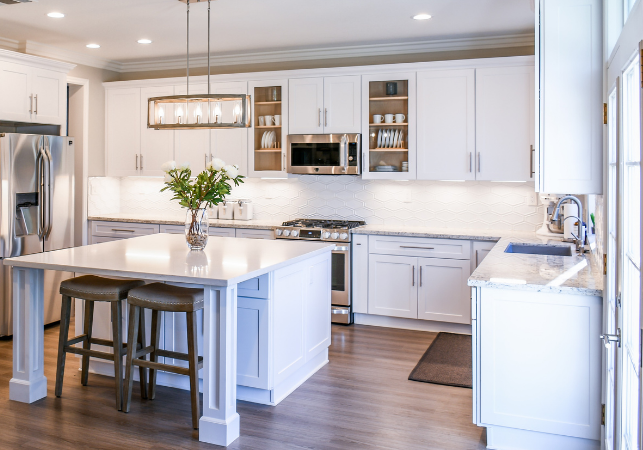Kitchen Cabinet Refinishing
KITCHEN CABINET CONTRACTOR
Get Your Kitchen Cabinets Looking Brand New With a Refinishing
Kitchen cabinets can last a lifetime with proper maintenance. Unfortunately, even well-maintained cabinets experience wear and tear from exposure to the elements. Since these are the cabinets most frequently used and seen in your home, you are bound to notice these cabinets when they start to look old and worn.
Now, before you call someone to rip those old kitchen cabinets, consider refinishing them. It will not only get your kitchen cabinets looking new but, more importantly, it will also save you money since it’s only a fraction of the cost compared to replacing them with new ones.
Moreover, if you’re remodeling your kitchen and you don’t plan to dramatically change the layout or frame of your cabinets, refinishing your cabinets is an excellent way to keep the budget of your remodel under control.
- Don’t hesitate, contact us for better business. Start a New Lisiting
KITCHEN CABINET CONTRACTOR
How Kitchen Cabinet Refinishing Works

Refinishing is done by stripping, sanding, and staining or painting your kitchen cabinets. The existing finish is stripped through chemical means or by sanding. Even if the finish has been chemically removed, some sanding is still required to ensure that the surfaces of your cabinets are level. And, lastly, the now bare kitchen cabinets are refinished with either stain or paint and a clear coat for protection.
Since there’s no need to rip out the old cabinetry and replace it with a new one, refinishing makes perfect sense in controlling the costs of kitchen remodels or renewing old kitchen cabinets. Furthermore, since the paint and stain can be different from its original, homeowners can achieve a new look for their kitchen by changing the colors in their kitchen even if they don’t configure their kitchen or cabinet layout.
Unlike cabinet refacing, refinishing does not involve changing any cabinet parts that can be refinished. If some parts require replacement, these are often due to them being in poor condition. The only replacements you can expect in any kitchen cabinet refinishing are the handles and hinges of the cabinet.
However, not all refinishing projects will involve the same steps or use the same products. After all, not all cabinets are made of the same wood. Moreover, the approach in repairing surface and water damage on cabinets will also vary on its particular material. This is why it’s more convenient to hire professionals for such a project since they already have the necessary tools and equipment for any situation.

Pros and Cons of Kitchen Cabinet Refinishing
Refinishing is a great way to rejuvenate the look of your kitchen cabinets and give your kitchen a more updated look. A simple change in the cabinet’s stain or color can go a long way in changing the style of your kitchen. Moreover, unlike refacing, refinishing would never hide the beautiful graining of hardwood kitchen cabinets.
Pros
● Change a cabinet to a different stain or color
● Will never hide the pronounced grains of hardwood
● Minimal cost
● Minor damage is easily repaired
● DIY friendly
Cons
● Not possible for laminate and non-wood material
● Repairs increase the turnaround time for refinishing
● DIY refinishing can take weeks
● Restyling is limited only to changing the color of the cabinet’s paint or stain
KITCHEN CABINET CONTRACTORS
The Step-by-step Process for Kitchen Cabinet Refinishing
1. Check the condition of the cabinet
The cabinets must first be assessed if they are suitable for refinishing. Any sign of cracks will be a waste to refinish since there will likely be more cracks on the wood in the future.
2. Purchase replacements for any part that cannot be refinished
Some cabinet manufacturers use particle or fiberboard doors and faces for their otherwise solid wood or plywood cabinets. These cannot be refinished without looking different from the rest of the cabinet.
3. Remove any removable parts
Refinishing a cabinet will be much easier when any screwed-on parts are removed. This includes the doors, drawers, and faces of your cabinet.
4. Clean all surfaces
Kitchen cabinets are notorious for having grease on their surfaces. You might not see it but trust us it’s there. With just a wipe of a rag moistened with mineral spirits, you will take off some of the grime that had built up over the years of being exposed to heat, dust, dirt, and oil in the kitchen.
5. Strip the cabinet of its existing finish
For physically stopping the finish by sanding, fine sandpaper, around 200 to 400 grit, should be used. On the other hand, for chemically stripping the finish, only the suitable chemical stripper for its current finish should be used.
6. Prepare the surfaces of your kitchen cabinet for refinishing
The surfaces of your cabinet need cleaning before applying a new layer of finish on it. If you sanded down the previous finish, any dust should be removed by wiping it off and cleaning it with a furniture cleaner.

